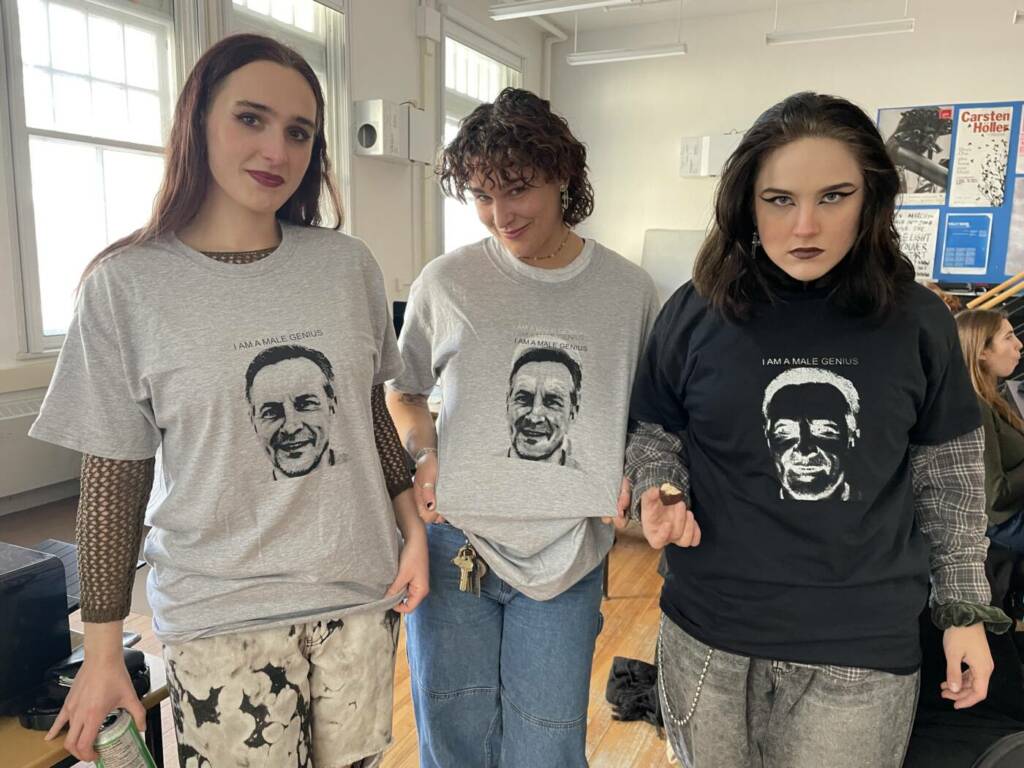
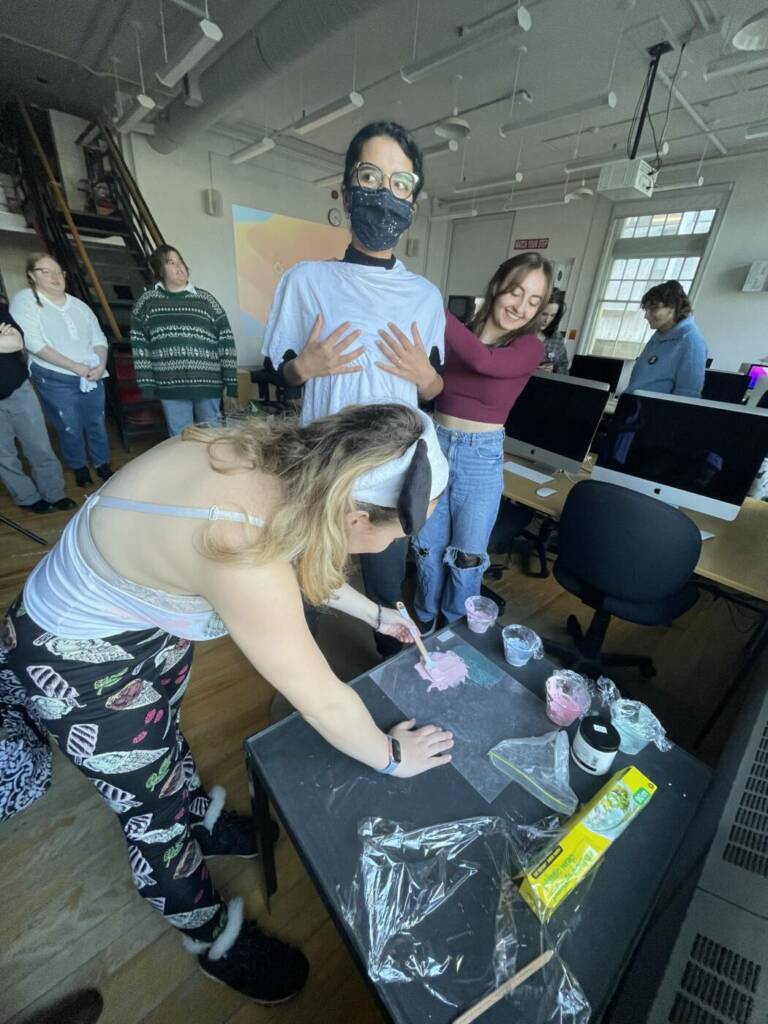
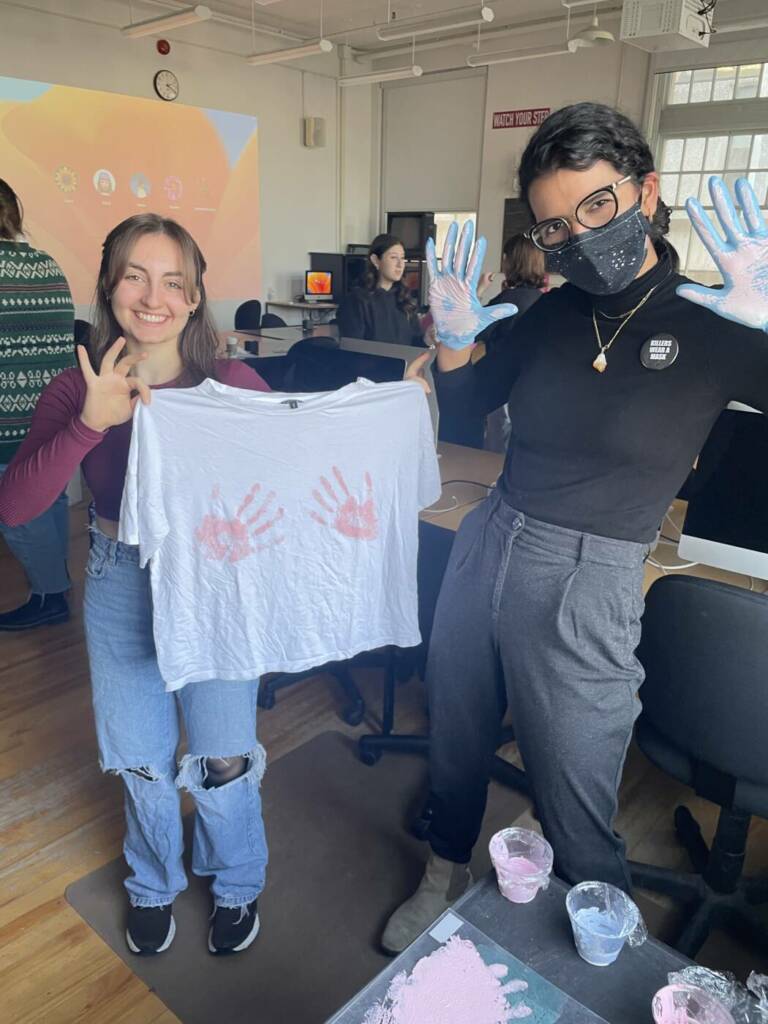

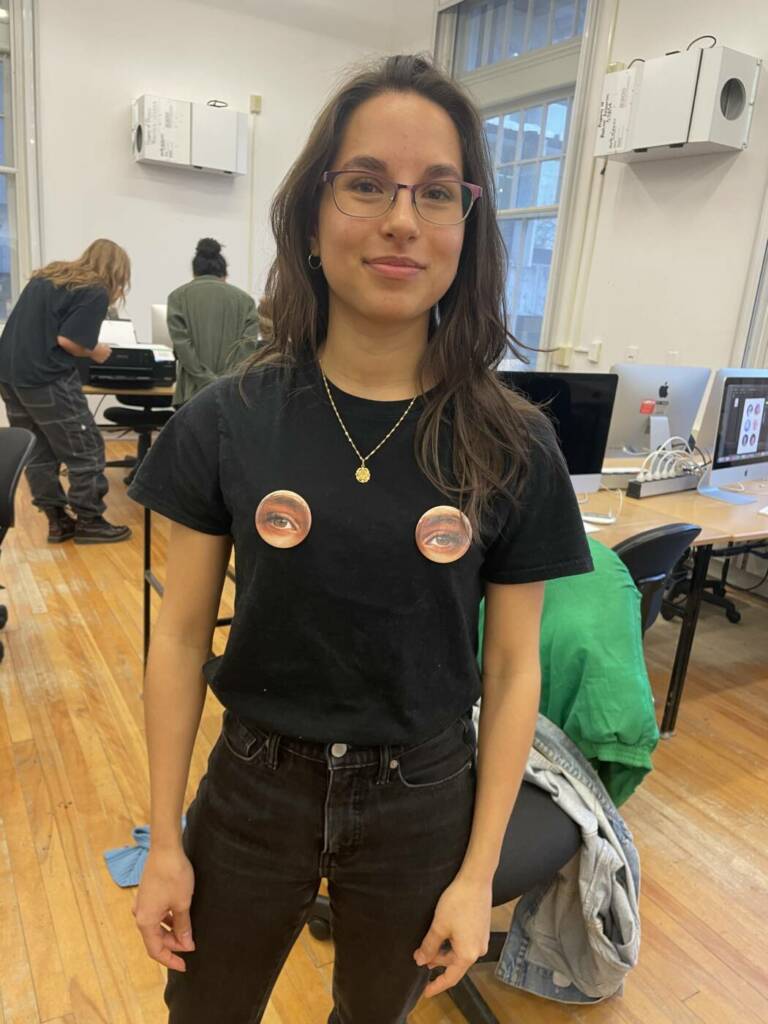





Visit to the copy shop in the UC – explore timelines for printing commercially
Discuss projects in progress
Work in class
Discuss projects in progress
Work in class
Note, participation grades can change before final submission of grades – attendance and presence for discussions, critiques, work in progress, and supporting your community matter. Please join us!
Critiques begin on TUESDAY next week – sign up for dates in class.
Artist Spotlight from Take A Stand playlist Art 21:
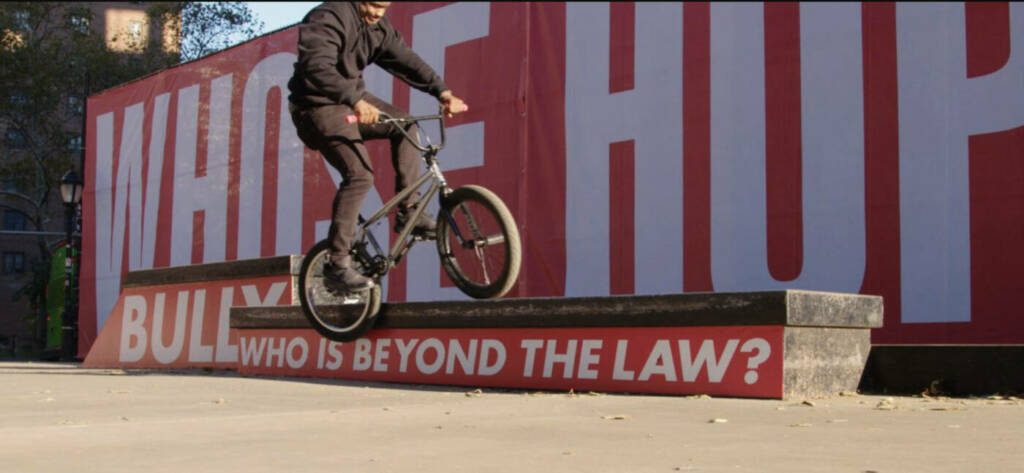
https://art21.org/watch/extended-play/barbara-kruger-part-of-the-discourse-short/

FINAL assignment: Make an Artist Multiple or Independent, Open Media work – all ideas to be discussed with instructor in class on THURSDAY this week.
Sign up for critiques in the last week!
RECOMMENDED MEDIA: Posters, post-cards, T-shirts, mugs, a set of stickers, banners, matchbooks, artist books, modified products, small sculptures or other commercially-printed or mass printed media.
Due: See schedule for details
______________________________________________________________________
Since the 1950’s artists have been making accessible works in a series/edition intended for wider distribution than an expensive “original”. They would undermine the idea of precious/one-of-a-kind artworks, and be related to everyday objects and operations.
They have been made as prints, small manufactured sculptures, pins, artist books, magazines, postcards, t-shirts and other commercially reproducible media.
Artist multiples are sometimes playful and mischievous – exploring new and surprising manifestations of commercial goods – for example they are personal, satiric, highly conceptual, queer, alternative to mainstream ideas etc. They can also convey activist messages intended for wide distribution.
Students will create a playful artist multiple in a form intended to be made in “multiple”. You can create one or more of your multiples, or a few items in a series – and consider the ideal “edition” size when you show your work in critique. Your work should be finished like a product in a store, and this may include packaging to finish the work.
Consider artist multiples by some of the following artists:
Hiba Abdallah
Sandy Plotnikoff
Dave Dyment
Yoko Ono
David Shrigley
Kelly Mark
Adam David Brown
Roula Partheniou
Paige Gratland
Micah Lexier
Jessie Eisner
Tracey Emin
Piero Manzoni
John Baldessari
Fiona Banner
Germaine Koh
Jenny Holzer
Fluxus (various)
Students will document finished works at the studio with a backdrop/or in action for addition to the blog.
Two “commercial” style photos of your multiple must be posted on the blog with a title and short description by the end of the day at least one week after the last class to receive a final grade.
Present books in progress draft 1
Discuss ideas in progress and make corrections for Thursday ORDERING DEADLINE
Present books in progress – remaining students
Complete cover designs, make corrections in consultation with Nathan and Diane
Export packages – NATHAN CONFIRMS AND ORDER BOOKS
Remember to post a PDF of your book on the blog – with a title and note about it – so it can be graded as “Book in Progress”. This is due by the end of the day Tuesday next week!
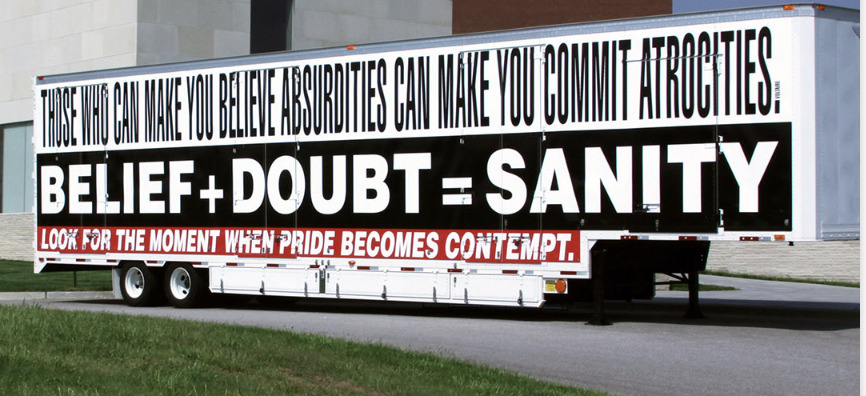
Watch the entire: Take A Stand playlist from Art 21 –
https://art21.org/playlist/taking-a-stand/
Make notes on two of the artists, and at least two artworks in total that you are interested in.
Discuss how the artists think about justice issues, and how they use strategies of agitation and transmission to “take a stand”. What kinds of unique tools and strategies can artists bring to activist projects? How does their work inspire your own thinking about art, and about justice? How could these artists influence your practice? Start thinking/making notes about an idea for a unique artist multiple you can start working on next week.
Note: Next week we will look at samples of artist multiples, and discuss our final assignment. Students can make a multiple in any medium – or – complete an independent work on any theme, in any medium due for show-and-tell discussion/critiques in the last week of classes. Be prepared to discuss some ideas in class.
Tuesday – (no class meeting, make up class on Sat. Oct 21 Toronto Field Trip)
Thursday –
Artist Talk from Evgenia
Demo on book layout design with Nathan
Discussions of ideas in development
Tues/Thurs:
Meetings with Diane about book in progress
Work time on scanning, layouts, and printing layouts in progress
BE BREPARED FOR AN IN-PROGRESS CRITIQUE ON TUESDAY with the class – there will limited time next week to correct, copyedit, and refine your design to be ordered for publication on Thursday by the end of class time.
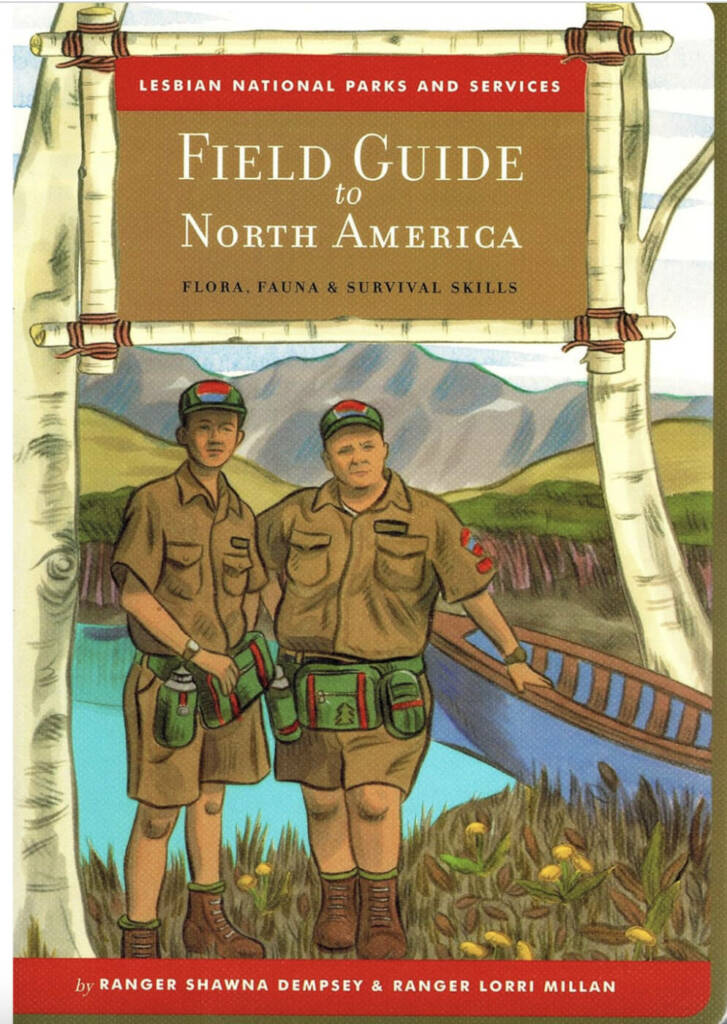

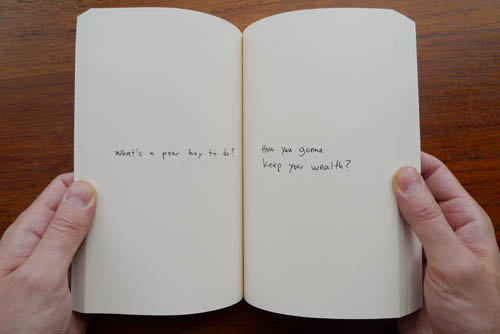

| Pop Quiz By Dave Dyment About the project: A near comprehensive collection of all of the questions posed in pop songs from the artist’s music collection. 360-page softcover artist’s book 5″ x 8″ Edition of 500, numbered and signed by the artist (each with unique handwritten question) $50 |
Experimental 2/3
Note on Schedule:
1. Book design workshop with Nathan
2. WORK IN PROGRESS due for discussion
3. ***Final works uploaded and submitted for printing deadline****
4. Works will also be discussed in progress during class.
Consider a book. Use any book you are interested in – a novel, a textbook, a book of essays, a field guide, a book of maps, a self-help book, an instruction manual, a cookbook, a memoir, a monograph… the possibilities are endless.
Choose one book as the point of departure for a print-on-demand artist book that you will develop and design in class. Like examples of artist publications discussed in class, your artist book will emphasize image over text and be an artwork in its own right. It can be any length or size available on Blurb.com under a budget of (total) $30 including taxes.
Your work can be about the book, use the book’s images, respond to or engage the book in any way. Consider content, text, meaning, and image in your work. The original book may or may not be visible or obvious in your finished work – but the artist book will represent your own version of the ideas in the book, and your own responses. The work may be discursive and legible, or it may be austere, formalized or abstract.
Strategies and motifs you may consider:
Scanning and photocopying from books
Using found photographs from the internet
Taking photographs
Working with appropriated text
Using text as image
Making a book from the past into the present
Focusing/repeating one detail in a book
Exploring visual references in the book
Responding to cover art, diagrams or illustrations in a book
Playing with scale
Rearrangements and reorientations
Drawing from books
More student examples:
See also: Dave Dyment and Nothing Else Press
Finish Environmental Video Art critiques
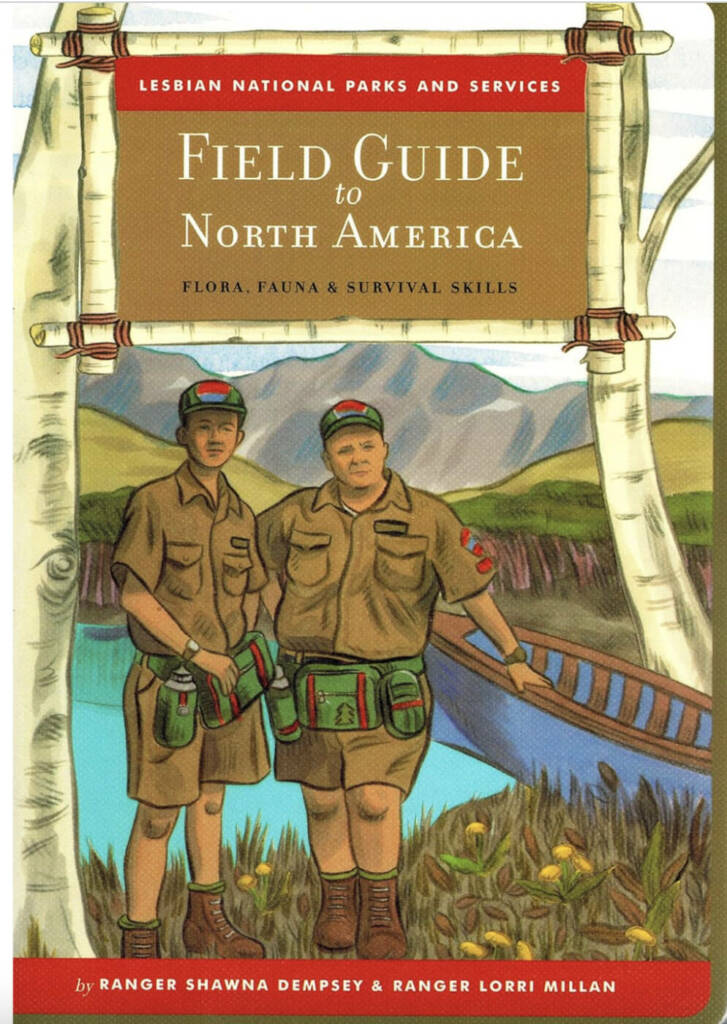
Discuss book design/concepts



| Pop Quiz By Dave Dyment About the project: A near comprehensive collection of all of the questions posed in pop songs from the artist’s music collection. 360-page softcover artist’s book 5″ x 8″ Edition of 500, numbered and signed by the artist (each with unique handwritten question) $50 |
Experimental 2/3
Note on Schedule:
1. Book design workshop with Nathan
2. WORK IN PROGRESS due for discussion
3. ***Final works uploaded and submitted for printing deadline****
4. Works will also be discussed in progress during class.
Consider a book. Use any book you are interested in – a novel, a textbook, a book of essays, a field guide, a book of maps, a self-help book, an instruction manual, a cookbook, a memoir, a monograph… the possibilities are endless.
Choose one book as the point of departure for a print-on-demand artist book that you will develop and design in class. Like examples of artist publications discussed in class, your artist book will emphasize image over text and be an artwork in its own right. It can be any length or size available on Blurb.com under a budget of (total) $30 including taxes.
Your work can be about the book, use the book’s images, respond to or engage the book in any way. Consider content, text, meaning, and image in your work. The original book may or may not be visible or obvious in your finished work – but the artist book will represent your own version of the ideas in the book, and your own responses. The work may be discursive and legible, or it may be austere, formalized or abstract.
Strategies and motifs you may consider:
Scanning and photocopying from books
Using found photographs from the internet
Taking photographs
Working with appropriated text
Using text as image
Making a book from the past into the present
Focusing/repeating one detail in a book
Exploring visual references in the book
Responding to cover art, diagrams or illustrations in a book
Playing with scale
Rearrangements and reorientations
Drawing from books
See also: Dave Dyment and Nothing Else Press
Student examples:
More student examples:
Field Trip Itinerary
Saturday Oct. 21, 2023
****BRING THIS ITINERARY WITH YOU. Share phone numbers with another classmate or class bus supervisor.
Bus departs UC loop at 9:30 am
Arrives at MOCA at 10:30 am
*Under 18 admission is free
* Student admission is $10 with ID
158 Sterling Road, Toronto, Ontario.
Admission PWYC (note main exhibit closed)
Also: Art Metropole
Bus departs MOCA at noon
Bus arrives at TPW at 12:15pm
170 St Helens Ave, Toronto,
Also: Daniel Faria Gallery/Clint Roenisch Gallery
But departs TPW at 12:45
Arrives at Kensington Market at 1:15
Corner of Augusta and Baldwin
Bus departs Kensington Market at 2:30pm
Bus arrives at Mercer Union at 3pm
1286 Bloor St. W
Bus departs Mercer Union at 3:30 pm
Bus arrives at U of Guelph UC Loop at approx. 5:00pm
Thanksgiving holiday
Critiques for Environmental Video Art